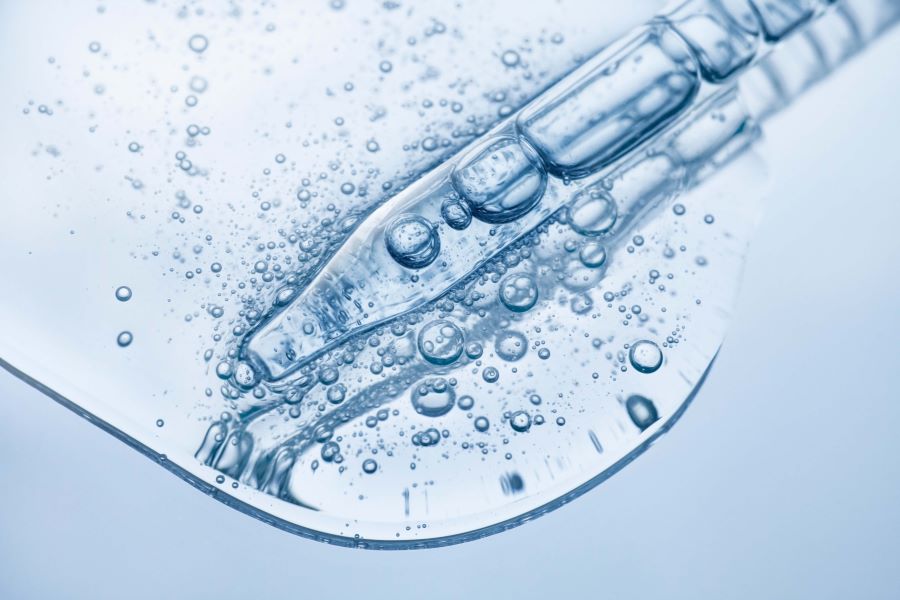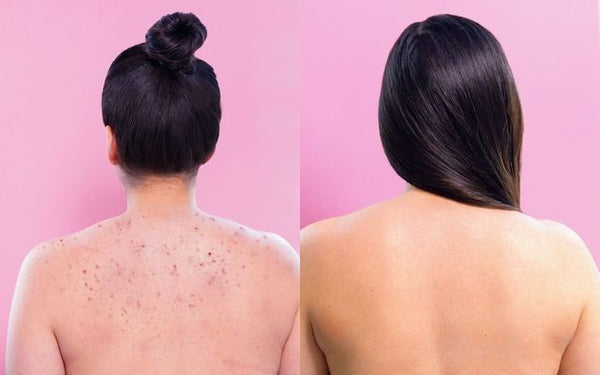What is Salicylic Acid? Ultimate Guide

Salicylic acid (SA) is an active ingredient that’s commonly used for treating and managing acne. While its main claim to fame is its ability to unclog pores and combat breakouts and blackheads, salicylic acid has many skin benefits, including treating warts, dandruff, and psoriasis.
So, what is salicylic acid and what can it do for your skin? This guide answers all your questions about SA, including: what are the benefits of salicylic acid for skin, how to use salicylic acid, is salicylic acid a BHA, does salicylic acid cause purging and much more.
What is Salicylic Acid?
Salicylic acid is a beta hydroxy acid (BHA), a chemical exfoliant that penetrates deep into the pores to dissolve dead skin cells, sebum, and impurities. This, in turn, can eliminate whiteheads and blackheads while preventing more spots from forming.
Salicylic acid is an over-the-counter (OTC) skincare ingredient that you’ll find in a range of skincare products, including cleansers, toners, serums, and lotions. It’s especially great for blemish prone skin but it can also be found in hair care products that control dandruff.
Chemically, salicylic acid is related to aspirin (acetylsalicylic acid), which works to decrease inflammation. In nature, salicylic acid is a product of the white willow tree and the leaves of the wintergreen shrub. Nowadays, however, it is made in the lab.
What Does Salicylic Acid Do to Your Skin?
Salicylic acid can do a lot for your skin. With its exfoliating, keratolytic, and anti-inflammatory properties, the BHA can help reduce blemishes, fade dark spots, minimize oily skin, smooth out bumpy skin texture, and even get rid of warts, corns, and calluses.
Thanks to its keratolytic effects, salicylic acid dissolves the keratin protein holding dead skin cells and flakes together. The buildup of dead cells and skin flakes in the pores can cause acne and blackheads. Salicylic acid helps to soften and loosen dry or dead cells.
As a chemical exfoliator, salicylic acid penetrates deep into the pore and oil gland to remove the accumulation of dead cells, excess oil, and impurities. This can both treat and prevent the occurrence of whiteheads, blackheads, and pimples.
Interestingly, salicylic acid also has anti-inflammatory activity that can reduce redness and skin irritation. It can help ease any redness or discomfort associated with acne while treating skin conditions such as dermatitis, keratosis pilaris, and psoriasis.
Best Salicylic Acid Cleanser
Looking for the best facial cleanser with salicylic acid? Here’s our top pick.
Key Ingredients: African Black Soap, Charcoal, Salicylic Acid | Targets: Blackheads, Breakouts, Hyperpigmentation
This salicylic acid face scrub helps to slough away dead cells and absorb excess oil with a purifying blend of charcoal and African black soap. It penetrates deep into the pores to intensely clean and prevent breakouts while improving skin tone for a clear, baby-soft complexion.
Salicylic Acid Benefits for Skin
Here are all the benefits of salicylic acid for your skin.
1: Fights and Prevents Acne
Is salicylic acid good for acne? Yes! That’s why you’ll find it in many acne treatments. In fact, it’s one of the best ingredients out there for treating and preventing acne breakouts. This is because it unclogs pores and removes dead skin cells, making the environment less suitable for acne-causing bacterial growth.
Thanks to its exfoliating properties, salicylic acid benefits skin by keeping the pores clean and clear, and therefore minimizing the occurrence of blemishes while combating existing ones. Most dermatologists would agree that salicylic acid works the best for oily and acne-prone skin types.
2: Reduces Oil Production
As an oil-soluble ingredient, SA can inhibit the sebaceous glands that produce oil by cutting through the skin’s fatty barrier and clearing away excess sebum that would clog the pores and lead to acne. By reducing oil production, salicylic acid can be helpful for oily skin types as it can help to reduce shine.
3: Treats Post-Inflammatory Hyperpigmentation
Studies show that salicylic acid peels can be effective for treating post inflammatory hyperpigmentation (PIH). Since salicylic acid works by exfoliating the deeper layers of the skin, it can visibly improve skin tone and texture. However, to see a noticeable improvement, salicylic acid peel treatments are the recommended course of action rather than regular OTC products which tend not to be potent enough to make a significant improvement.
4: Soothes Inflammation
A chemical called salicin, found in salicylic acid, has anti-inflammatory properties that can help reduce redness from acne and sunburn. However, it’s always best to prevent sunburn altogether by wearing sunscreen every day.
5: Manages Certain Skin Conditions
Salicylic acid has been shown to treat symptoms associated with psoriasis and keratosis pilaris. Keratosis pilaris is a common skin condition characterized by rough, bumpy skin, typically on the arms and thighs. Salicylic acid’s exfoliating properties help to smooth the skin’s surface and reduce the appearance of bumps associated with this condition.
Best Salicylic Acid Products
What are the best salicylic acid skincare products? Here are our faves. One even won a Teen Vogue Award!
Key Ingredients: Salicylic Acid, Glycolic Acid, Niacinamide, Blue Tansy | Targets: Body Acne, Post Inflammatory Hyperpigmentation, Acne Scars
This 4-step body acne routine harnesses the pore-unclogging powers of AHAs and BHAs to fight pesky zits on the chest, back, and butt while healing acne marks and scars. You get: our award-winning body cleanser, mist, lotion, and pimple patches to get you clear all over.
How to Use Salicylic Acid
Wondering how to use salicylic acid for acne? Here’s a skincare routine you can try featuring salicylic acid for a clearer complexion.
Step 1: Cleanse
Start by washing your face with a salicylic acid cleanser such as Truly’s 24K Gold Black Soap Impurity Cleanser. This will remove the buildup of dirt, grime, and dead cells to prevent blemishes from reappearing. Gently massage into wet skin, let it sit for 60 seconds, then rinse off.
Step 2: Tone
After cleansing, apply a salicylic acid toner or face mist. Truly’s Tansy Water Mist is a great option as it will deep clean your pores with salicylic acid while soothing and hydrating the skin with blue tansy and beta glucan. Simply spritz onto skin.
Step 3: Moisturize
Now that you’ve cleansed and toned with salicylic acid, it’s time to seal in all those active ingredients and supply the skin with hydration. Truly’s Glass Skin Facial Serum is a lightweight, non-greasy formula that hydrates, reduces shine, and refines pores with a blend of jojoba oil, niacinamide and probiotics. Massage a couple of pumps into clean skin.
Tips for Using Salicylic Acid
Start Slowly: If you’re new to salicylic acid, start with a lower concentration product (around 1-2%) to allow your skin to adjust. Using a higher concentration from the outset can cause irritation, especially for sensitive skin types.
Patch Test: Before applying salicylic acid to your face, perform a patch test on a small area of your skin to check for any adverse reactions or allergies.
Limit Frequency: Start by using salicylic acid once every other day or every few days, then gradually increase frequency as your skin adjusts. Overuse can lead to irritation, so it’s essential to find the right balance for your skin.
Consider Buffering: If you have sensitive skin, consider “buffering” the salicylic acid by applying a moisturizer first and then applying the salicylic acid on top. This can help mitigate potential irritation while still allowing the product to be effective.
Side Effects of Salicylic Acid
Like with most active ingredients, there’s always the chance of side effects from salicylic acid, especially if you’ve got sensitive skin or you’re only just introducing it into your skincare routine. Some salicylic acid side effects include dryness, irritation, stinging, peeling, and redness.
If you experience any of these side effects from using salicylic acid, use it less often until your skin adjusts to it. Salicylic acid can make skin more sensitive to the sun so it’s always important to wear SPF to protect your skin and avoid further irritation.
Salicylic acid can be combined with many other active ingredients. However, it’s best to avoid using it alongside irritating agents like retinoids, benzoyl peroxide, and Retin-A (tretinoin).
Salicylic Acid Before and After Photos
How good is salicylic acid for acne? Salicylic acid is pretty much a gold standard for treating acne. Need proof? Here are some before and after photos showing how effective salicylic acid is at clearing up acne when using Truly's Bodne Routine.

Salicylic Acid FAQ
Got questions about the use of salicylic acid or this active ingredient in general? We’ve answered some of the most common questions about salicylic acid.
Is Salicylic Acid a BHA?
Yes, salicylic acid is a beta hydroxy acid (BHA). It works by exfoliating the skin to remove the accumulation of dead skin cells, dirt, and oil that clog pores and potentially cause breakouts. For that reason, salicylic acid is commonly found in acne treatments. In fact, it is considered to be one of the best ingredients for treating acne thanks to its ability to penetrate deep into the pores.
Does Salicylic Acid Cause Purging?
Skin purging means an increased rate of skin cell turnover which can lead to red, irritated skin. It often occurs when an active ingredient like salicylic acid comes in contact with skin and rapidly brings congestion to the skin’s surface, resulting in breakouts. Salicylic acid can cause purging, which is essentially temporary acne. However, it should clear up within 3-4 weeks.
Who Should Not Use Salicylic Acid?
Salicylic acid is generally safe for everyone. However, in the case that you experience redness, burning, stinging, or an allergic reaction, it’s best to limit your use or stop using it altogether. It’s common when you first start using it to experience some symptoms like redness and dryness, but if your skin just isn’t happy with salicylic acid, it’s best to find an alternative instead. If you have dry or sensitive skin, avoid using it on large areas of your body to avoid irritation.
Is it Okay to Use Salicylic Acid Every Day?
Using salicylic every day should be safe. However, it could cause dryness or irritation, especially if you have dry or sensitive skin. The experts recommend applying it just three times a week in the beginning, and working your way up from there. If you have severely dry skin, avoid applying SA all over your skin. Apply it to the affected areas only.
How Long Does it Take for Salicylic Acid to Work?
Unfortunately, using salicylic acid won’t give you clearer skin overnight. According to dermatologists, you’ll likely see results from salicylic acid in around four to six weeks. Some people may notice an improvement in their skin much sooner. However, if you’re using it as an acne treatment, make sure you give it the full six weeks to allow it to take effect.
Is Salicylic Acid Safe While Breastfeeding?
While it lacks an FDA pregnancy rating, salicylic acid topical is considered safe during pregnancy and breastfeeding. This is because it is unlikely to be absorbed into breast milk, according to a 2018 study. Speak to a healthcare professional if you have any questions or concerns. Salicylic acid supplements, however, are considered unsafe during pregnancy and breastfeeding.



























































